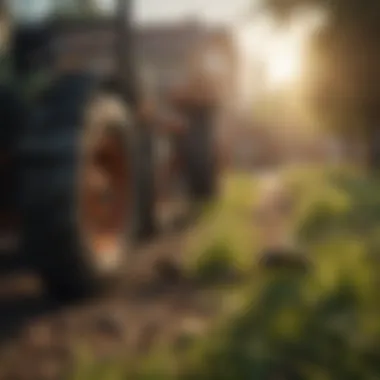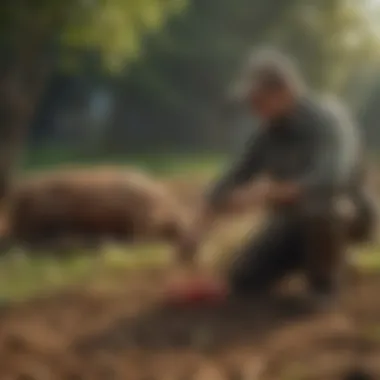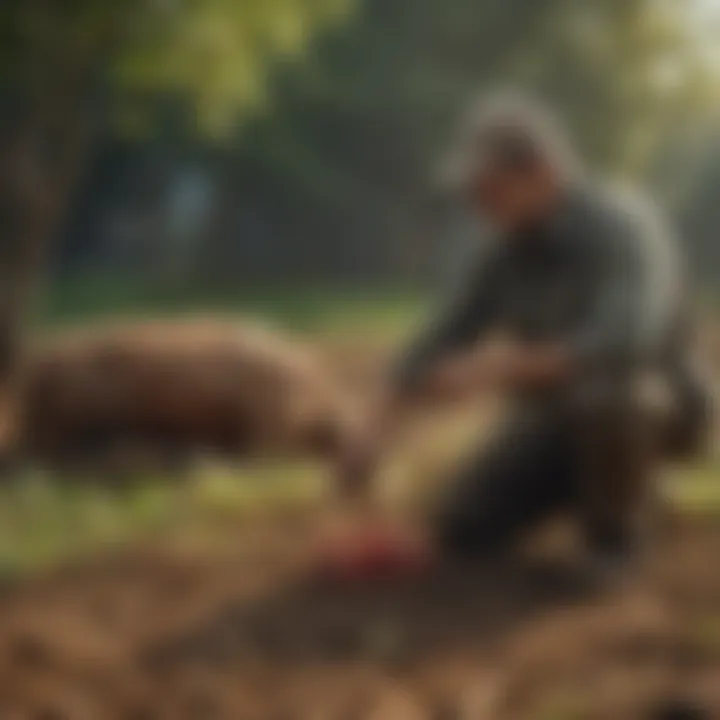Systematic Pest Elimination for Sustainable Farming


Intro
In modern agriculture, pest management remains a critical focus for farmers. Understanding the balance between pest control and sustainability is essential. Effective pest management not only protects crops but also conserves the ecosystem. This article presents a detailed guide to systematic pest elimination, aiming to enlighten agricultural professionals and enthusiasts alike.
Latest Trends in Agriculture
Overview of Current Trends
Agricultural practices evolve continually. Recently, there is a push for reducing chemical inputs. Farmers are exploring integrated pest management (IPM) strategies, which prioritize sustainable methods. Crop rotation and biodiversity are more relevant now than ever. These practices enhance soil health and create natural barriers to pests.
Impact of Technology on Farming Practices
Technological advancements reshape the agricultural landscape. Drones and sensors collect data on crop health. This information assists in making informed decisions regarding pest control. Precision agriculture tools can significantly reduce chemical use. By targeting specific areas, farmers preserve beneficial organisms while minimizing harm to the environment. The role of technology in agriculture is clearly expanding and showing promise.
Sustainable Practices: Towards a Greener Future
Importance of Sustainability in Agriculture
Sustainability is not just a buzzword; it's a necessity for the future of agriculture. Sustainable practices benefit both the environment and farm profitability. By integrating ecological principles, farmers can reduce their reliance on synthetic inputs. This proactive approach maintains soil fertility and enhances water retention.
Methods for Sustainable Farming
Implementing sustainable farming methods is crucial. Some common approaches include:
- Cover cropping: Utilizes plants grown primarily for the enrichment of soil rather than for harvest.
- Reduced tillage: Minimizes soil disturbance, aiding in soil structure preservation.
- Companion planting: Pairs crops that benefit each other, reducing pest populations naturally.
Each of these methods contributes to a greener agricultural future. Encouraging biodiversity is not only good for pest management but also supports overall ecosystem health.
Gardening Techniques and Tips
Essential Gardening Tools and Equipment
Efficient gardening requires the right tools. Essential equipment includes:
- Hand trowels: For planting and digging.
- Pruning shears: To maintain plant health and shape.
- Spray bottles: For applying pesticides or natural solutions like neem oil.
Optimal usage of these tools can significantly enhance pest management and overall garden health.
Seasonal Gardening Practices
Timing greatly affects gardening success. Seasonal practices help in pest control. For instance, early planting of certain crops can evade specific pests. Crop rotation helps disrupt pest life cycles. Understanding these practices prepares gardeners for effective management throughout the year.
"Integrating modern techniques with traditional knowledge fosters a balanced approach to pest management, ensuring the sustainability of agricultural practices."
Epilogue
The need for systematic pest elimination in sustainable agriculture is pressing. By staying informed about trends, embracing sustainable practices, and employing effective gardening techniques, farmers can create a resilient farming system. The comprehensive understanding of pest behavior and control mechanisms is necessary for successful agricultural practices.
Understanding Systematic Pest Elimination
Systematic pest elimination encompasses a well-structured approach to managing pest populations in agriculture. This is essential for ensuring the sustainability of farming practices. The significance of this topic lies in its multi-faceted benefits, which include improved crop yields, reduced environmental impact, and enhanced ecosystem health. Understanding the principles behind systematic pest elimination equips agricultural professionals with the knowledge to make informed decisions.
Definition and Importance
Systematic pest elimination can be defined as an organized method for controlling pest populations through various strategies that minimize their negative impact on crops. The importance of this approach cannot be overstated. Conventional methods often rely on chemical pesticides, which may harm beneficial insects, soil health, or even water supplies. Systematic pest elimination seeks to mitigate these risks by incorporating more sustainable techniques. This includes Integrated Pest Management (IPM), which emphasizes preventive measures and use of natural predators.
In adopting this approach, farmers can increase their resilience to pest outbreaks. It also promotes biodiversity, thereby fostering a healthier agricultural ecosystem. By understanding pest behaviors and their ecological roles, farmers can make more strategic choices that lead to long-term benefits.
Historical Context
The historical context of pest management dates back to ancient agriculture, where farmers used simple methods to protect their crops from pests. Early techniques included manual removal or employing natural predators, like birds. As agriculture evolved, so did the methods to combat pests. In the 20th century, the introduction of synthetic pesticides revolutionized pest control, offering immediate relief but simultaneously ushering in issues of resistance and environmental degradation.
In response to these drawbacks, the late 20th century saw a shift towards sustainable practices. Researchers and practitioners began recognizing the importance of integrating ecological interconnectedness into pest management. This led to the development of policies and frameworks around Integrated Pest Management and other innovative strategies. The evolution of our understanding of ecosystems has prompted a re-evaluation of pest control methods, demonstrating a collective move towards more sustainable agricultural practices.
"Sustainable agriculture practices require a profound understanding of pest dynamics and their relationships within the ecosystem.”
In summary, comprehending systematic pest elimination is vital for modern agricultural practices. The historical transition from primitive techniques to contemporary sustainable methods highlights the need for ongoing adaptation. By embracing these practices, farmers not only protect their crops but also contribute to the health of the environment.


The Ecology of Pests
Understanding the ecology of pests is crucial in any discussion on systematic pest elimination. This section addresses how pests interact with their environment and the broader impact they have on agriculture. Knowledge of pest ecology informs effective management strategies that balance pest control with sustainable practices. In agriculture, this balance is essential; it nurtures crop production while ensuring that ecosystems remain intact.
Types of Agricultural Pests
Agricultural pests can be classified primarily into biotic and abiotic types. Understanding these categories helps to tailor pest management strategies appropriately, allowing farmers to address specific challenges they face in their fields.
Biotic Pests
Biotic pests are living organisms that affect crops negatively. Examples include insects, rodents, and nematodes. These pests can reproduce quickly and often cause significant agricultural damage. A key characteristic of biotic pests is their higher reproduction rates, leading to potential population explosions. This makes them particularly concerning for farmers.
The advantage of focusing on biotic pests is their predictability in behavior and biology. Farmers can harvest data regarding their life cycles, making it easier to predict when they will be most destructive. Understanding these patterns allows for more effective preventive measures.
However, the downside is that they can develop resistance to control methods over time. Integrated Pest Management (IPM) can mitigate this risk by employing various control strategies to manage populations effectively while minimizing resistance.
Abiotic Pests
Abiotic pests include non-living stresses such as drought, salinity, and temperature extremes. These factors can drastically influence crop health, causing damage that can sometimes be more severe than that caused by biotic pests. A significant characteristic of abiotic pests is that they are often not directly observable, making them challenging to pinpoint.
They benefit this article as understanding abiotic factors leads to essential discussions on resilient agricultural practices. Farmers can design strategies that mitigate the effects of these factors, such as using drought-resistant crop varieties or optimizing irrigation.
The disadvantage here is the unpredictability of abiotic stresses, as they can be influenced by broader climate change patterns. This adds complexity to pest management strategies.
Pest Life Cycle
The life cycle of pests plays a pivotal role in how they affect crops. Their growth and reproduction cycle gives insights into when and how to combat these organisms effectively.
Reproductive Phases
Reproductive phases involve the periods during which pests reproduce. Depending on environmental conditions, this phase can be quick or prolonged. Recognizing these phases aids in timing interventions precisely when pest populations are likely to increase, leading to maximum efficacy in control measures.
Understanding the reproductive phases can lead to smarter pest management. Farmers can apply control measures just before a population explosion, reducing costs and minimizing crop loss.
However, it can also be a disadvantage if not accurately predicted, as mistakes in timing can lead to unmanageable pest populations.
Environmental Influences
Environmental influences such as humidity, temperature, and presence of natural predators have significant roles in the life cycles of pests. These factors can trigger different reproductive phases or emergences.
Studying environmental influences improves our ability to predict pest behavior and outbreaks. This adaptation is essential in developing sustainable pest control measures that align with natural ecosystems.
On the flip side, environmental influences can vary widely and unpredictably, complicating effective pest management strategies and necessitating flexible approaches that can adapt quickly to changing conditions.
Understanding both biotic and abiotic pests, along with their life cycles, is crucial for farmers as they navigate the complex landscape of sustainable agriculture.
Methodologies of Systematic Pest Elimination
The methodologies of systematic pest elimination are crucial. They form the backbone of sustainable agriculture practices. These methodologies provide a framework that balances the need for crop yield with ecological integrity. Understanding these methods enables farmers to apply strategies that address pest problems effectively while minimizing harm to non-target organisms and the environment. The integration of various approaches can lead to a more resilient agricultural system, one that adapts to changing pest populations and environmental conditions with efficiency.
Integrated Pest Management (IPM)
Definition of IPM
Integrated Pest Management, or IPM, is a sustainable approach that combines multiple strategies for controlling pests. It recognizes the complexity of agricultural ecosystems and aims to manage pest populations in a way that reduces the reliance on chemical pesticides. This method is advantageous because it promotes long-term pest control through a combination of biological, cultural, physical, and chemical tools. The unique feature of IPM is its emphasis on monitoring and understanding pest life cycles, allowing tailored interventions that minimize environmental impact. However, its implementation requires knowledge and commitment from farmers, which can sometimes be challenging.
Key Components
The key components of IPM include monitoring, identification of pests, and decision-making based on established thresholds for pest action. Regular monitoring is vital as it allows farmers to observe pest populations and make informed choices about intervention. Another important aspect is the selection of the appropriate control option, which could involve biological control methods or, if necessary, targeted use of pesticides. This multipronged approach makes IPM a cornerstone in sustainable agriculture. One disadvantage, however, is that it may not always lead to immediate results, requiring patience and continued effort.
Cultural Control Techniques
Crop Rotation
Crop rotation involves changing the type of crop grown in a specific area over seasons. This method is beneficial as it disrupts pest life cycles and reduces soil nutrient depletion. Additionally, it can improve soil health by promoting a diverse microbial ecosystem. Crop rotation is a popular choice for sustainable pest management due to its effectiveness in minimizing pest populations and improving overall yield. However, planning rotations effectively can be complex and may require varying knowledge about both crops and pest behavior.
Soil Management
Soil management techniques greatly influence pest prevalence. Healthy soils foster strong crops that can withstand pest pressures. Good practices include maintaining organic matter, controlling soil erosion, and ensuring adequate drainage. These practices are beneficial because they enhance soil structure and fertility. The unique advantage of effective soil management is its ability to create a robust agricultural ecosystem. On the downside, it can be labor-intensive and may require a financial investment to implement proper soil care.


Biological Control Methods
Natural Predators
Utilizing natural predators is a common biological control method. This method involves introducing organisms that prey on pests, effectively reducing their populations. Natural predators can stabilize pest numbers without the side effects of chemical applications. This concept is beneficial and aligns with sustainable agriculture goals, leading to healthier biodiversity. However, reliance on natural predators may not be effective in all situations, particularly when pest populations explode unexpectedly.
Pathogens and Parasites
Pathogens and parasites can also be harnessed to control pest populations. They introduce diseases or induce parasitism in target pests, ultimately leading to their decline. This method can be particularly effective in managing specific pest populations over time. The significant advantage of using pathogens is that they often have minimal impact on beneficial species. However, challenges include the careful timing and application to ensure that the pathogens effectively target the intended pest without unnecessary spread.
Chemical Control Options
Insecticides
Insecticides are chemical substances designed to kill insects. They can effectively manage pest populations quickly and are commonly used in agriculture. However, insecticides can also have detrimental effects on non-target species, including beneficial insects and the broader ecosystem. Their immediate effectiveness makes them a common choice, but overuse can lead to resistance among pests, making future management more complicated.
Herbicides
Herbicides target unwanted plants that compete with crops for resources. They are beneficial because they can reduce weed populations and thus enhance crop yields. Herbicides are popular due to their ease of use and quick results in weed management. Nonetheless, there is a risk of developing resistant weed populations and potential harm to surrounding vegetation, which requires careful consideration and responsible use among farmers.
Technological Innovations in Pest Management
Technological innovations play a crucial role in enhancing the methods of pest management in agriculture. By integrating advanced technology, farmers can tackle pest issues more efficiently and sustainably. These innovations help in monitoring pest populations, ensuring timely interventions and minimizing environmental impacts. The two major components of this technological advancement include precision agriculture and data analytics.
Precision Agriculture
Drone Technology
Drone technology is rapidly transforming pest management practices. These unmanned aerial vehicles provide a bird's-eye view of agricultural fields, allowing for real-time data collection. The key characteristic of drone technology is its ability to cover large areas quickly, identifying specific locations that may require intervention. This is beneficial for targeting precise areas for pest control while reducing the amount of chemicals applied over a broader range.
One unique feature of drones is their capability to gather high-resolution imagery. This advanced imaging can highlight stressed crops, enabling farmers to assess pest damage quickly. However, the use of drones does have some disadvantages, such as high initial costs and the need for trained personnel to operate them properly.
Remote Sensing
Remote sensing technology complements drone usage by providing comprehensive data about crop health and environmental conditions. It utilizes satellite imagery and ground sensors to track changes over time. The key characteristic of remote sensing is its capacity to gather data from various sources, thus creating a holistic view of pest infestations. This technology is popular in modern agriculture due to its ability to assist in predicting potential outbreaks.
A unique feature of remote sensing is its ability to provide historical data trends. This helps growers make informed decisions based on past infestations and climatic conditions. There are disadvantages as well, including the dependency on technology and potential gaps in data coverage, making ground truthing still necessary.
Data Analytics in Pest Control
Predictive Modelling
Predictive modelling utilizes algorithms and historical data to forecast pest outbreaks. This specific aspect enhances proactive pest management strategies. The key characteristic is its use of data patterns, allowing farmers to anticipate pest behavior and make informed decisions before issues escalate. This approach benefits farmers by reducing the economic impact of pest infestations.
A unique advantage of predictive modelling is its capacity for scenario analysis, which helps in evaluating different pest management strategies. However, it may require substantial data input and technical expertise, which could present a barrier for some farmers.
Real-time Monitoring
Real-time monitoring involves continuous tracking of pest populations through various technologies such as sensors and mobile applications. This practice helps in quick identification of pest presence. The key characteristic is its ability to alert farmers instantly about pest activity, enabling rapid response. This immediacy makes it a highly beneficial choice in pest management.
One unique feature of real-time monitoring is the integration with other technologies like weather forecasting systems. This can provide context for pest activity based on environmental conditions. However, it can be costly to implement the necessary technology, and reliability can vary based on location and connectivity issues.
In summary, both precision agriculture and data analytics revolutionize pest management by providing farmers with the tools needed to anticipate, identify, and address pest issues effectively. By leveraging these technologies, sustainable practices become more attainable and efficient.
Evaluating the Effectiveness of Pest Management Strategies
Evaluating the effectiveness of pest management strategies is crucial for achieving sustainable agriculture. It involves assessing whether implemented methodologies lead to the desired outcomes regarding pest control. This evaluation also offers insights into the efficiency, economic viability, and environmental impact of these strategies. Understanding their effectiveness helps farmers make informed decisions that contribute to long-term agricultural sustainability and ecosystem health.
Monitoring and Assessment
Field Trials
Field trials serve as a practical approach to assess pest management strategies in real-world conditions. They involve experimenting with various pest control measures across different agricultural settings. The primary characteristic of field trials is their experimental nature, as they are designed to test hypotheses about pest control methods. This makes field trials a beneficial choice because they provide empirical data that can inform best practices in pest management.
One unique feature of field trials is their ability to gauge both efficacy and adaptability of pest control measures. They allow for the observation of pest behavior and response to applied strategies in situ. However, challenges may arise such as variability in results due to external factors like weather or soil conditions. Thus, careful design is necessary to ensure that field trials yield reliable data.
Data Collection Techniques
Data collection techniques are essential to systematically gather information about pest populations and the effectiveness of management strategies. These techniques may include surveys, traps, and digital monitoring tools, all of which provide invaluable insights into pest dynamics. The key characteristic of these techniques is their versatility, allowing for the collection of both qualitative and quantitative data relevant to pest management.


One unique feature of data collection techniques is the increase in accuracy achieved through technological tools, such as remote sensors and mobile apps. These tools enhance data quality but also require proper training and familiarity among users. The primary advantage is that detailed and timely data can lead to more effective decision-making, while a disadvantage may include the potential costs associated with implementing advanced data collection technologies.
Impact on Crop Yield and Quality
Assessing the impact of pest management strategies on crop yield and quality is central to evaluating their effectiveness. It encourages farmers to consider not just the quantity of produce but also its quality, which can influence market value. Effective pest management should contribute to healthier crop development by minimizing losses and improving overall yield. The assessment of crop yield and quality involves looking at various factors such as pest damage, nutrient availability, and soil health.
Understanding the value of incorporating various pest control strategies can significantly enhance the sustainability of agricultural practices.
Ethical Considerations in Pest Control
Understanding the ethical implications of pest control is vital in today’s agricultural landscape. As farmers and researchers navigate the delicate balance between productivity and environmental sustainability, ethical considerations emerge as a guiding principle for effective pest management. This section outlines the significant aspects that warrant attention, emphasizing their benefits and essential considerations.
Ecosystem Health
Ecosystem health forms the backbone of sustainable agriculture. A healthy ecosystem supports biodiversity, provides natural pest control mechanisms, and enhances soil fertility. Employing pest control strategies that prioritize ecosystem health can lead to sustainable outcomes.
Key points to consider include:
- Biodiversity: Maintaining diverse plant and animal species helps dilute pest populations. For instance, promoting a variety of crops can encourage beneficial organisms that naturally suppress pest outbreaks.
- Soil Quality: Healthy soil supports robust plant growth and resilience against pests. Practices such as organic matter incorporation and reduced chemical use foster soil health.
- Water Management: Efficient water use promotes plant vigor. Managing irrigation can prevent conditions that favor pest proliferation.
"Ecosystem health is not merely a concept; it is a commitment to protecting our natural resources for future generations."
Sustainability Practices
Sustainability practices in pest management considerably enhance both ethical and practical outcomes. These practices are aligned with long-term agricultural resilience, protecting the environment while meeting food demands.
Consider implementing the following sustainability practices:
- Integrated Pest Management (IPM): This holistic approach combines various strategies such as biological, cultural, and chemical controls. By emphasizing the use of natural pest predators, IPM minimizes reliance on harmful pesticides.
- Crop Rotation and Diversity: Switching crops seasonally disrupts the life cycles of pests, leading to lower populations over time. This approach maintains soil nutrients and reduces disease persistence.
- Organic Farming Techniques: Utilizing natural fertilizers and pest deterrents not only decreases environmental harm but also can enhance market appeal to consumers increasingly focused on organic products.
By considering ethics in pest control, agricultural professionals can ensure their practices lead to healthier ecosystems and sustainable food production. Aligning pest management with ethical principles fosters productivity while safeguarding the environment.
Future Directions in Pest Management Research
The issue of pest management is constantly evolving as new challenges arise from climate change, invasive species, and shifting agricultural practices. Therefore, examining future directions in pest management research is crucial. This research not only aims to improve pest control methods but also addresses issues related to sustainability and environmental impact. By investing in innovative solutions, farmers can enhance efficiency and productivity while minimizing harm to ecosystems.
Advancements in pest management techniques can lead to higher crop yields and reduced losses, which is paramount for food security. Furthermore, these directions often align with the principles of sustainable agriculture, offering a balanced approach to pest control. Researchers and agriculturalists must particularly consider emerging technologies and regulatory frameworks to facilitate this progress.
Emerging Technologies
Emerging technologies play a pivotal role in shaping future pest management strategies. The integration of these tools into agricultural practices helps farmers monitor pest populations more accurately and respond more swiftly. Some notable technologies include:
- Genetic Engineering: Techniques like CRISPR can create pest-resistant crops, reducing the need for chemical interventions.
- Biotechnology: Producing natural pest repellents and biopesticides from organic materials.
- Internet of Things (IoT): Sensors can provide real-time data on pest activity, helping farmers make informed decisions.
- Artificial Intelligence (AI): Machine learning algorithms predict pest outbreaks based on historical data, allowing for proactive measures.
Investing in these technologies not only tackles pest issues but also aligns with movement towards a more sustainable agricultural model.
Policy and Regulation Implications
Alongside technological advancements, the implications of policies and regulations must be considered. For instance, policymakers need to adapt existing regulations to accommodate new methods and products emerging from research. Key considerations include:
- Safety Assessments: New technologies must undergo rigorous evaluation to ensure they are safe for humans and the environment.
- Incentives for Sustainable Practices: Governments can drive changes by offering grants or subsidies for adopting innovative pest management solutions.
- Collaboration Between Sectors: Engaging stakeholders, including researchers, farmers, and policymakers ensures that regulations support effective practices rather than hinder them.
- International Standards: As agriculture is a global industry, harmonizing policies can help manage pests that cross borders more effectively.
"The right combination of technology, policy, and sustainable practice is essential in overcoming future pest management challenges."
By focusing on both emerging technologies and sound policies, we can create a robust framework for pest management that ensures long-term sustainability and productivity in our agricultural system. Engaging the agriculture community is vital for fostering research that resonates with actual farming conditions and challenges.
Closures and Recommendations
The conclusions and recommendations section serves a pivotal role in encapsulating the essential findings of this comprehensive exploration into systematic pest elimination. It synthesizes the knowledge gained from various methodologies and recent advancements in pest management, thereby reinforcing the importance of sustainable practices. In agriculture, addressing pest challenges is not merely an activity but a fundamental component that significantly impacts crop health, yield, and environmental well-being.
Key benefits of a well-informed conclusion include the solidification of best practices in pest management, the encouragement of ecological balance, and the promotion of sustainable operations for future generations. Effective pest management is not static; it evolves with new research and real-world application, and thus, a dynamic approach is essential.
Moreover, integrating findings from different areas such as technological innovations, cultural practices, and ethical considerations enables farmers and researchers to have a holistic view leading to smarter, more effective strategies that can be adapted to various situations.
"A sustainable pest management strategy is an investment in the future of agriculture, equipping farmers with the tools they need to protect their crops while safeguarding ecosystem health."
Summary of Key Points
- Understanding Systematic Pest Elimination: This involves grasping its definition and recognizing its significance in sustainable agriculture.
- Pest Ecology: Proper identification of pest types and comprehending their life cycles provide insights pivotal for systematic management.
- Methodologies of Systematic Pest Elimination: Emphasis on integrated approaches — combining cultural, biological, and chemical methods enhances effectiveness.
- Technological Innovations: Precision agriculture and data analytics streamline pest management while reducing environmental impact.
- Effectiveness Evaluation: Continuous monitoring and assessment yields needed data to adjust strategies for optimal results.
- Ethical Considerations: Maintaining ecosystem health and sustainability is critical in any pest management scenario.
- Future Directions: Awareness of emerging technologies and regulatory impacts will help shape the landscape of agricultural pest management.
Practical Takeaways for Farmers and Researchers
- Adopt Integrated Pest Management (IPM): Employ a combination of pest control methods tailored to specific agriculture situations. This can include adjusting planting schedules and employing natural predators to reduce reliance on chemical solutions.
- Utilize Technological Tools: Investing in drone technology and remote sensing can give farmers real-time insights into pest populations, leading to quicker and more effective responses.
- Data Collection is Key: Engaging in continuous monitoring and utilizing predictive models allow for proactive management instead of reactive measures, which can save both time and resources.
- Collaborate and Share Knowledge: Strong relationships among farmers, researchers, and local agricultural extensions promote the exchange of innovative ideas and methodologies.
- Prioritize Sustainable Practices: Ensure that all pest management strategies align with sustainability goals, promoting a balanced ecosystem while ensuring crop protection.
By embracing these recommendations, agricultural practitioners can not only enhance their pest management strategies but also contribute positively to the broader goal of sustainable agriculture.







